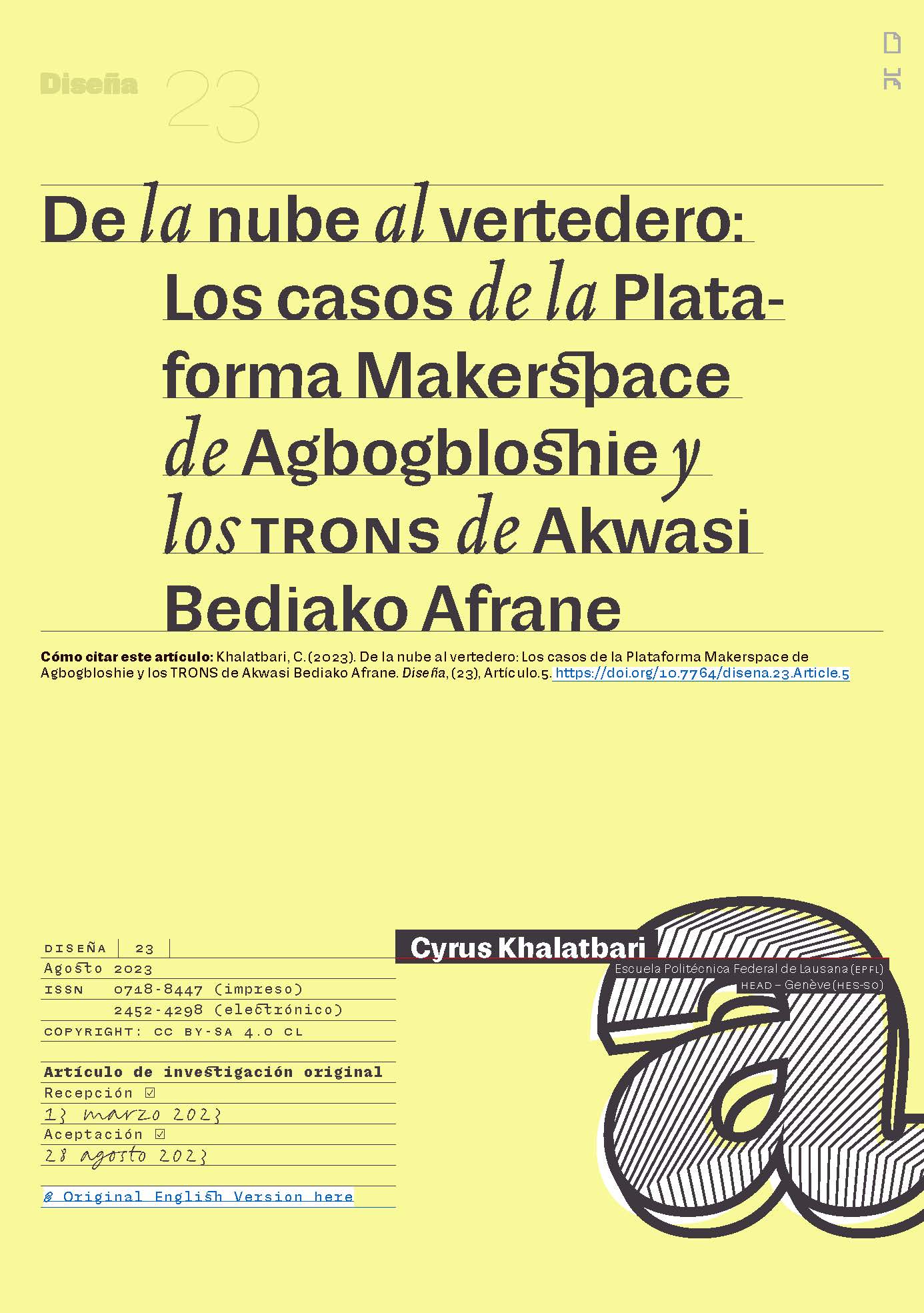De la nube al vertedero: Los casos de la Plataforma Makerspace de Agbogbloshie y los TRONS de Akwasi Bediako Afrane
Contenido principal del artículo
Resumen
Este trabajo contribuye al conocimiento sobre la reparación de productos electrónicos desechados en Accra, Ghana. Después de hacer dialogar estas prácticas con las narrativas occidentales y eurocéntricas que giran en torno a la materialidad de las interacciones digitales y sus infraestructuras, el artículo se adentra en dos iniciativas artísticas y de diseño que operan en el contexto del vertedero de residuos electrónicos y sitio de procesamiento de Agbogbloshie (Ghana). El primero es un estudio de caso sobre la Plataforma Makerspace de Agbogbloshie (AMP), una iniciativa de hacer (y deshacer) crítico que empodera a los reparadores y desmontadores locales a través de métodos de diseño colaborativo de código abierto. La contribución se centra luego en el trabajo de Akwasi Bediako Afrane, un artista medial ghanés que critica nuestra condición sociotécnica y especula sobre ella a través de un trabajo de reapropiación de computadoras desechadas. Posicionando estas iniciativas en el contexto más amplio de nuestras narrativas dominantes sobre Internet y la computación, el artículo destaca la importancia de estas prácticas para abordar la condición planetaria de los residuos electrónicos y crear conciencia sobre ella.
Descargas
Detalles del artículo

Esta obra está bajo una licencia internacional Creative Commons Atribución-CompartirIgual 4.0.

Este obra está bajo una licencia de Creative Commons Reconocimiento-CompartirIgual 4.0 Internacional.
NOTA DE COPYRIGHT
Todos los contenidos de esta edición electrónica se distribuyen bajo licencia Creative Commons de “Atribución-Copartirigual 4.0 Internacional” (CC-BY-SA). Cualquier reproducción total o parcial del material deberá citar su procedencia.
Los derechos de las imágenes publicadas pertenecen a sus autores, quienes otorgan a Diseña la licencia para su uso. La gestión de los permisos y la autorización de publicación de las imágenes (o de cualquier material) que contenga derechos de autor y sus consecuentes derechos de reproducción en esta publicación es de exclusiva responsabilidad de los autores de los artículos.
Citas
Afrane, A. B. (2022). Game of TRONS: A Play Around With Consumer Electronic Gadgets. TRONSpuppet. https://www.gameoftrons.com
Agamben, G. (2009). “What Is an Apparatus?” and Other Essays. Stanford University Press.
Akese, G., Beisel, U., & Muntaka Chasant, M. (2022, July 21). Agbogbloshie: A Year after the Violent Demolition. African Arguments. https://africanarguments.org/2022/07/agbogbloshie-a-year-after-the-violent-demolition/
Barbrook, R., & Cameron, A. (1996). The Californian Ideology. Science as Culture, 6(1), 44–72. https://doi.org/10.1080/09505439609526455
Baxter, G., & Sommerville, I. (2011). Socio-technical Systems: From Design Methods to Systems Engineering. Interacting with Computers, 23(1), 4–17. https://doi.org/10.1016/j.intcom.2010.07.003
Buchanan, R. (2001). Design Research and the New Learning. Design Issues, 17(4), 3–23. https://doi.org/10.1162/07479360152681056
Burrell, J. (2012). Invisible Users: Youth in the Internet Cafés of Urban Ghana. MIT Press.
“Crisis in Agbogbloshie, Ghana, Caused by Forced Dismantlement of the Landfill.” (2021, July 10). Electrònica Justa. https://electronicajusta.net/crisis-in-agbogbloshie-ghana-caused-by-forced-dismantlement-of-the-landfill/
Dunne, A., & Raby, F. (2013). Speculative Everything: Design, Fiction, and Social Dreaming. MIT Press.
Efthymiou, L., Mavragani, A., & Tsagarakis, K. P. (2016). Quantifying the Effect of Macroeconomic and Social Factors on Illegal E-Waste Trade. International Journal of Environmental Research and Public Health, 13(8), Article 8. https://doi.org/10.3390/ijerph13080789
Emery, F. E., & Trist, E. L. (1960). Socio-technical Systems. In C. W. Churchman & M. Verhulst (Eds.), Management Sciences, Models and Techniques (Vol. 2, pp. 83–97). Pergamon Press.
Ensmenger, N. (2018). The Environmental History of Computing. Technology and Culture, 59(4), S7–S33. https://doi.org/10.1353/tech.2018.0148
Gaboury, J. (2018). Critical Unmaking: Toward a Queer Computation. In J. Sayers (Ed.), The Routledge Companion to Media Studies and Digital Humanities (pp. 483–491). Routledge.
Gabrys, J. (2013). Digital Rubbish: A Natural History of Electronics. University of Michigan Press.
Hertz, G. (2009). What is Critical Making? Current. https://current.ecuad.ca/what-is-critical-making
Hertz, G., & Parikka, J. (2012). Zombie Media: Circuit Bending Media Archaeology into an Art Method. Leonardo, 45(5), 424–430. https://doi.org/10.1162/LEON_a_00438
Hu, T.-H. (2016). A Prehistory of the Cloud. MIT Press.
Latour, B. (1999). Pandora’s Hope: Essays on the Reality of Science Studies. Harvard University Press.
Lundgren, K. (2012). The Global Impact of e-Waste: Addressing the Challenge [Report]. International Labour Organization. http://www.ilo.org/sector/Resources/publications/WCMS_196105/lang--en/index.htm
Lupton, E., & Miller, J. A. (1992). The Bathroom, the Kitchen and the Aesthetics of Waste: A Process of Elimination. Princeton Architectural Press.
Moore, J. W. (2015). Capitalism in the Web of Life: Ecology and the Accumulation of Capital. Verso.
Osseo-Asare, D., & Abbas, Y. (2015). Investigating 3E-materials at Agbogbloshie in Accra, Ghana. Proceedings of the Engineering4Society 2015 Conference, 41–50. https://doi.org/10.1109/Engineering4Society.2015.7177898
Osseo-Asare, D., & Abbas, Y. (2021). Occupying Africa: Prototyping a Transformal Makerspace Network. Architectural Design, 91(5), 62–69. https://doi.org/10.1002/ad.2733
Perkins, D. N., Drisse, M.-N. B., Nxele, T., & Sly, P. D. (2014). E-Waste: A Global Hazard. Annals of Global Health, 80(4), Article 4. https://doi.org/10.1016/j.aogh.2014.10.001
Potter, C., Osseo-Asare, D., & M’Rithaa, M. K. (2019). Crafting Spaces Between Design and Futures: The Case of the Agbogbloshie Makerspace Platform. In S. Candy & C. Potter (Eds.), Design and Futures (Vol. 1). Tamkang University Press.
Scanlan, J. (2005). On Garbage. Reaktion.
Seidu, F., & Kaifie, A. (2022). The End of Informal E-waste Recycling in Accra, Ghana? Annals of Work Exposures and Health, 66(8), 1091–1093. https://doi.org/10.1093/annweh/wxac050
Sengers, P., Boehner, K., David, S., & Kaye, J. “Jofish.” (2005). Reflective Design. Proceedings of the 4th Decennial Conference on Critical Computing: Between Sense and Sensibility, 49–58. https://doi.org/10.1145/1094562.1094569
Sterne, J. (2007). Out with the Trash: On the Future of New Media. In C. R. Acland (Ed.), Residual Media (pp. 16–31). University of Minnesota Press.
Winner, L. (1980). Do Artifacts Have Politics? Daedalus, 109(1), 121–136.
Wittsiepe, J., Feldt, T., Till, H., Burchard, G., Wilhelm, M., & Fobil, J. N. (2017). Pilot Study on the Internal Exposure to Heavy Metals of Informal-level Electronic Waste Workers in Agbogbloshie, Accra, Ghana. Environmental Science and Pollution Research International, 24(3), 3097–3107. https://doi.org/10.1007/s11356-016-8002-5

